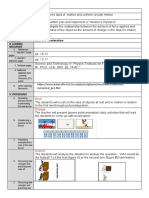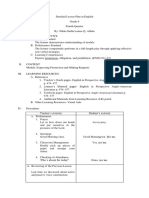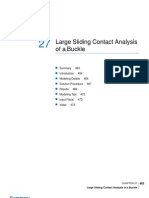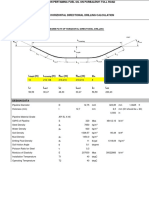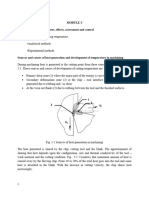DLP Science g8
DLP Science g8
Uploaded by
Krizzia Lovely PerezCopyright:
Available Formats
DLP Science g8
DLP Science g8
Uploaded by
Krizzia Lovely PerezOriginal Description:
Original Title
Copyright
Available Formats
Share this document
Did you find this document useful?
Is this content inappropriate?
Copyright:
Available Formats
DLP Science g8
DLP Science g8
Uploaded by
Krizzia Lovely PerezCopyright:
Available Formats
Semi- Detailed Lesson Plan in Science
Grade 8
First Quarter
I. OBJECTIVES
A. Content Standards The learner demonstrates understanding of Newton’s three
laws of motion and uniform circular motion.
B. Performance Standards The learner shall be able to develop a writer plan and
implement a “Newton’s Olympics”.
C. Learning Competencies / Objectives (S8FE-Ia-15)
Write the LC code for each
Investigate the relationship between the amount of force
applied and the mass of the object to the amount of change in
the object’s motion.
Objectives:
1. Identify the forces acting on an object at rest.
2. Explain why objects stay at rest.
II. CONTENT Module I: FORCES AND MOTION
Lesson 1: BALANCED AND UNBALANCED FORCES
III. LEARNING RESOURCES
A. References
1. Teacher's Guide Pages pp. 5 - 8
2. Learner's Materials Pages pp. 3 - 6
3. Textbook Pages
4. Additional Materials from Learning
Resource (LR) portal
B. Other Learning Resource Lesson Guide Science 8 (First Quarter- pp. 1-5)
https://www.google.com.ph/search?
pictures&oq=balanced+and+unbalanced+forces
IV. PROCEDURES
Teacher’s Activity Student’s Activity
a. Preliminaries
1. Prayer
Let us bow down our heads and Let us pray.
put ourselves in the presence of
the Lord.
2. Greetings
Good Morning class. Good Morning too, Ma’am.
3. Classroom Management
Kindly pick up pieces of paper and Yes, ma’am.
arrange your chairs.
4. Checking of Attendance
Who’s absent for today? None, ma’am.
Reviewing previous lesson or Present the following statement in class and ask the students if they
presenting the new lesson agree or disagree with them. Select two to three students per group to
justify or explain their answer.
A. 1. Force is needed to stop an object.
2. Force always results to motion.
3. Force can act even at a distance.
4. Objects have the tendency to remain at rest.
5. Objects have the tendency to resist change.
B. Establishing a purpose for the Lesson Analyze the pictures (to be presented on the television screen) (can
be printed)
Presenting examples / instances of the
C. new lesson What have you observed on the picture presented?
Discussing new concepts and The teacher will place a ball or any object on top of a table and ask:
practicing
new skills #1
D.
a) Will this object move by itself?
b) How can we make this object move?
c) While it is moving, how can we make the object speed up or slow
down?
d) How can make it stop?
e) How can we make it change its direction?
E. Discussing new concepts and Do the activity 1 Forces on object at rest in Lesson Guide Science 8
practicing (First Quarter) pp. 5 or LM pp. 5- 6
new skills #2
Developing mastery Presentation of the output per group/ Processing:
(Leads to Formative Assessment 3)
Analysis:
Situation 1
1. Is the pen at rest or in motion?
2. Are there forces acting on the pen? If yes, draw the forces. You may
F. use arrows to represent these forces.
3. What happens to the pen? What could have caused the pen’s motion?
Situation 2
1. Is the book at rest or in motion?
2. Are there forces acting on the book? If yes, draw the forces
acting on the book.
3. Did the book move? How will you make the book move?
Finding practical applications of Since friction is a resistance force that slows down or prevent motion,
G. concepts there are advantages and disadvantages that friction may do.
and skills in daily living How is friction important in:
a. walking
b. writing
c. running vehicles
Making generalizations and 1. What is force?
H. abstractions 2. What are some other forces that can cause something to move?
about the lesson 3. How does gravity affect object on earth?
4. What is a force that can cause an object to slow down or have little
movement?
5. In your own words define friction.
I. Evaluating Learning Multiple Choice: Read each statement carefully and write only the letter
of the correct answer.
1. A book is at rest on top of a table. Which of the following is correct?
A. There is no force acting on the book.
B. The book has no inertia.
C. There is no force acting on the table.
*D. The book is in equilibrium.
2. Which of the following situations involves friction?
A. A bicycle rolling down a hill
B. A baseball player sliding into 2nd base
C. A diver falling through the air to a pool
*D. All of the above experience some friction.
3. What is gravity?
A. Newton’s first law
B. The force that objects exert on each other because of their
masses
*C The downward pull on the Earth
D. The friction that an object has put on it
4. Which is the best example of gravity?
A. A car hits a tree, and its motion stops
B. A breeze blows, and a sailboat moves
C. A book is pushed, and it moves across the table
*D. A person drops a ball, and it falls to the ground
5. How does Earth ‘s gravity affect objects near Earth?
A. It pushes them away.
*B. It pulls them in
C. It makes them larger.
D. It makes them move faster.
Additional activities for application or Ask the students to write situation/ examples where the presence of
J. remediation other forces are beneficial.
V. REMARKS
VI. REFLECTION
A. No. of learners who earned 80% in the
evaluation
B. No. of learners who require additional
activities for remediation who scored
below 80%
C. Did the remedial lessons work? No. of
learners
who have caught up with the lesson
D. No. of learners who continue to require
remediation
E. Which of my teaching strategies worked
well? Why did these worked?
F. What difficulties did I encounter which my
principal or supervisor can help me solve?
G. What innovation or localized materials did
I
Use or discover which I wish to share with
other teachers?
You might also like
- Science ProbeDocument258 pagesScience ProbeoakesmNo ratings yet
- DLL Grade 8 First Grading - FinalDocument96 pagesDLL Grade 8 First Grading - FinalChai Barcelon95% (161)
- 7E Science Lesson Plan For DemoDocument3 pages7E Science Lesson Plan For DemoThea De GuzmanNo ratings yet
- Primary Science 5 Workbook PDFDocument88 pagesPrimary Science 5 Workbook PDFEfe Ege88% (8)
- Isa-Tr75 25 02-2000Document40 pagesIsa-Tr75 25 02-2000Daniel Leonardo Barrera EspartaNo ratings yet
- Demo Lesson Plan AccelerationDocument4 pagesDemo Lesson Plan Accelerationmarizel ortega100% (1)
- Daily Lesson Log Grade 8 3bDocument2 pagesDaily Lesson Log Grade 8 3bRaymund Aliling100% (3)
- Detailed Lesson Plan in Physics Grade 8Document5 pagesDetailed Lesson Plan in Physics Grade 8Juloura PastorNo ratings yet
- DLL Division DEMO Physical ChangeDocument6 pagesDLL Division DEMO Physical ChangeJR Pellejera100% (1)
- Instructional Lesson Plan in Science 8Document4 pagesInstructional Lesson Plan in Science 8ESTHER MAE ANN TRUGILLO100% (1)
- DLP August 19,2019Document2 pagesDLP August 19,2019Shane Catherine Besares100% (1)
- LESSON-EXEMPLAR-Science-Grade-8 Third CODocument4 pagesLESSON-EXEMPLAR-Science-Grade-8 Third COruvin100% (4)
- Daily Lesson Log Grade 8 1.ADocument4 pagesDaily Lesson Log Grade 8 1.ARaymund AlilingNo ratings yet
- Grade 8 DLLDocument331 pagesGrade 8 DLLanon_29890413250% (2)
- Detailed Science Lesson Plan 1Document2 pagesDetailed Science Lesson Plan 1Lorraine DonioNo ratings yet
- DLL Science 8Document5 pagesDLL Science 8marichuNo ratings yet
- Lesson Plan in Science 1Document1 pageLesson Plan in Science 1Brigette Darren Baste ColitaNo ratings yet
- Division of Bohol Science 8 Quarter 1 - Week 3 (Day 1) : S8FE-Ia-16)Document4 pagesDivision of Bohol Science 8 Quarter 1 - Week 3 (Day 1) : S8FE-Ia-16)Johndion A. RulomaNo ratings yet
- RTOT Force, Mtion and Energy Group 4a Ntot 2018 - 2Document6 pagesRTOT Force, Mtion and Energy Group 4a Ntot 2018 - 2Daphnie Serate NunezNo ratings yet
- LP 3rd LawDocument5 pagesLP 3rd LawRoan Joy BalbalosaNo ratings yet
- Lesson Plan in Science Grade 8: Schools Division of Aurora Puangi National High SchoolDocument2 pagesLesson Plan in Science Grade 8: Schools Division of Aurora Puangi National High SchoolFernando AbuanNo ratings yet
- Republic of The Philippines: Department of Education Region IIIDocument3 pagesRepublic of The Philippines: Department of Education Region IIIMichaelAbdonDomingoFavoNo ratings yet
- Regional Mass Training of Trainers On The Critical Content of Science Grade 8Document3 pagesRegional Mass Training of Trainers On The Critical Content of Science Grade 8Kebu Yen100% (1)
- Lesson PlanDocument5 pagesLesson PlanJohn Ryan Dango Tabayag100% (1)
- LP - Science 8 - Balanced & Unbalanced ForcesDocument5 pagesLP - Science 8 - Balanced & Unbalanced ForcesDominique Louise SolisNo ratings yet
- Lesson 2 Balanced and Unbalanced ForceDocument5 pagesLesson 2 Balanced and Unbalanced ForceSedwell SentNo ratings yet
- SCIENCE 8 Daily-Lesson-Log - 1ST DAYDocument3 pagesSCIENCE 8 Daily-Lesson-Log - 1ST DAYRebecca Implica TuvillejaNo ratings yet
- G8-Fidelity 1Document4 pagesG8-Fidelity 1Emma T Sogo-anNo ratings yet
- Third Law of MotionDocument6 pagesThird Law of MotionSer GutieNo ratings yet
- Science 8 DLLDocument9 pagesScience 8 DLLLovie Alfonso0% (1)
- DLP Law of InertiaDocument5 pagesDLP Law of InertiaJULIE ANN PAJENo ratings yet
- 17a. Newtons Firts Law of MotionDocument18 pages17a. Newtons Firts Law of MotionVicky Fortuna OliverosNo ratings yet
- Newtons Ist Law of MotionDocument3 pagesNewtons Ist Law of MotionNaome100% (1)
- Detailed LP in Periodic Table OrigDocument7 pagesDetailed LP in Periodic Table Origjallie niepesNo ratings yet
- Glenn's DLLDocument6 pagesGlenn's DLLLovely Shiena C. AragoncilloNo ratings yet
- Dec 2-7 Week 4 Grade 8 Science DLLDocument2 pagesDec 2-7 Week 4 Grade 8 Science DLLRicardo Acosta Subad100% (4)
- DLP 31 G-8 3RDDocument2 pagesDLP 31 G-8 3RDVimson Alastra100% (1)
- FOR COT..... Observation 1 JingDocument4 pagesFOR COT..... Observation 1 JingJearalyn Jun Inso100% (1)
- The Learners Demonstrate An Understanding ofDocument3 pagesThe Learners Demonstrate An Understanding ofJeffrey Selpo BondadNo ratings yet
- Daily Lesson Plan For Grade 8 Science (CHEMISTRY 8)Document4 pagesDaily Lesson Plan For Grade 8 Science (CHEMISTRY 8)Ma. Socorro Hilario100% (2)
- Sci 8. DLL. Q1. W1 2Document6 pagesSci 8. DLL. Q1. W1 2Marilou Cambronero SalazarNo ratings yet
- Science Department 8 First First 1 Physics: I. ObjectivesDocument10 pagesScience Department 8 First First 1 Physics: I. ObjectivesAllister Lee Gaerlan CruzNo ratings yet
- G8-Science-Daily Lesson Log DLL TemplateDocument3 pagesG8-Science-Daily Lesson Log DLL TemplateDewson Pacudz100% (1)
- S9ES - Ia-J36.6: Detailed Lesson Plan Grade 8 Quarter 1 Week 2 PagesDocument4 pagesS9ES - Ia-J36.6: Detailed Lesson Plan Grade 8 Quarter 1 Week 2 PagesArceli Valdoz DomingoNo ratings yet
- LP TyphoonDocument4 pagesLP TyphoonMae Anne SalcedoNo ratings yet
- Development of The Periodic Table Lesson PlanDocument9 pagesDevelopment of The Periodic Table Lesson Planbella100% (1)
- Cot Q4 Grade 8Document8 pagesCot Q4 Grade 8veberlyNo ratings yet
- S8Mt-Iiia-B-8 S8Mt-Iiic-D-9Document3 pagesS8Mt-Iiia-B-8 S8Mt-Iiic-D-9LENETTE ALAGON100% (2)
- DLP Sci8 W5-3Document3 pagesDLP Sci8 W5-3Vanessa Joy SaavedraNo ratings yet
- Daily Lesson Plan: Ramon Avanceña National High SchoolDocument2 pagesDaily Lesson Plan: Ramon Avanceña National High SchoolShane Catherine BesaresNo ratings yet
- COTDocument3 pagesCOTMykelCañete100% (2)
- 1st Quarter Cot 2Document3 pages1st Quarter Cot 2Juliet Ileto Villaruel - Almonacid83% (6)
- Law of Interaction (Innovators Group)Document2 pagesLaw of Interaction (Innovators Group)Jheaz Zelle100% (4)
- Example of Semi-Detailed LPDocument11 pagesExample of Semi-Detailed LPjerosh12386% (7)
- Detailed Lesson Plan in Physics Grade 8Document5 pagesDetailed Lesson Plan in Physics Grade 8Bon PatiñoNo ratings yet
- Daily Lesson Log: Laptop, ProjectorDocument5 pagesDaily Lesson Log: Laptop, ProjectorFabio Jr CapitoNo ratings yet
- Group 1 DLP HEAT AND TEMPERATUREDocument2 pagesGroup 1 DLP HEAT AND TEMPERATUREJeazel MosendoNo ratings yet
- LP in Science 8Document68 pagesLP in Science 8cheryl vidaja100% (1)
- Science 8 3rd April 5-9, 2021: Learning Area Grade Level Quarter DateDocument2 pagesScience 8 3rd April 5-9, 2021: Learning Area Grade Level Quarter DateCriselAlamag100% (2)
- DETAILED LESSON PLAN - Law of InteractionDocument3 pagesDETAILED LESSON PLAN - Law of Interactionjoseph novaNo ratings yet
- DLL Grade 8 First Grading FinalDocument95 pagesDLL Grade 8 First Grading FinalRenz LaraNo ratings yet
- DLL Science 8 1stDocument119 pagesDLL Science 8 1stJESSAN DE PEDRONo ratings yet
- DLL Science 8 S.y.2023-2024Document106 pagesDLL Science 8 S.y.2023-2024Jolmar A RudelaNo ratings yet
- I. Objectives A. Content Standards: (Write The LC Code For Each)Document4 pagesI. Objectives A. Content Standards: (Write The LC Code For Each)Krizzia Lovely PerezNo ratings yet
- Graduation Day A Special DayDocument4 pagesGraduation Day A Special DayKrizzia Lovely PerezNo ratings yet
- Detailed LP - ModalsDocument8 pagesDetailed LP - ModalsKrizzia Lovely Perez100% (1)
- Code of Ethics of Professional Teachers: Perspectives On Culture and Implications For EducationDocument88 pagesCode of Ethics of Professional Teachers: Perspectives On Culture and Implications For EducationKrizzia Lovely PerezNo ratings yet
- Code of Ethics FinalDocument88 pagesCode of Ethics FinalKrizzia Lovely PerezNo ratings yet
- Travel Drive ExampleDocument10 pagesTravel Drive Examplep-nicoNo ratings yet
- Practica Dinamica Del VehiculoDocument18 pagesPractica Dinamica Del Vehiculodroid11No ratings yet
- Heavy Duty Actuator - BrochureDocument16 pagesHeavy Duty Actuator - BrochureRedzaNo ratings yet
- Roller Coaster Physics: Vocabulary: Friction, Gravitational Potential Energy, Kinetic Energy, Momentum, VelocityDocument5 pagesRoller Coaster Physics: Vocabulary: Friction, Gravitational Potential Energy, Kinetic Energy, Momentum, VelocityAnnabelle WolfNo ratings yet
- Basic Concepts and Theory: Bearing History and TimelineDocument21 pagesBasic Concepts and Theory: Bearing History and TimelineGyana Ranjan RoutNo ratings yet
- Report On Basic Skid Resistance TestDocument48 pagesReport On Basic Skid Resistance TestMohammad Umair91% (11)
- Materials Questions Edexcel Unit 1 PhysicsDocument8 pagesMaterials Questions Edexcel Unit 1 Physicshajrah978No ratings yet
- Properties of WaterDocument20 pagesProperties of WaterRicha MahajanNo ratings yet
- Listagem ASTM Volume 03 02 CorrosionDocument6 pagesListagem ASTM Volume 03 02 CorrosionCamilla BragançaNo ratings yet
- DFI2000 Paper White PDFDocument12 pagesDFI2000 Paper White PDFDavid WhiteNo ratings yet
- Chapter 27: Large Sliding Analysis of A BuckleDocument12 pagesChapter 27: Large Sliding Analysis of A BuckleDan WolfNo ratings yet
- HDD Lesson and LearnDocument10 pagesHDD Lesson and Learnbagus handoko100% (1)
- 8.biomechanics and SportsDocument27 pages8.biomechanics and SportsAdityaNo ratings yet
- The Laws of MotionDocument44 pagesThe Laws of MotionPHAKVISETH PEMNo ratings yet
- Totalenergies Open GearsDocument88 pagesTotalenergies Open GearsMohammad HosseiniNo ratings yet
- SPH3U 3-2F - WORK, ENERGY POWER ASSIGNMENT UpdatedDocument18 pagesSPH3U 3-2F - WORK, ENERGY POWER ASSIGNMENT UpdatedlarrylynnmailNo ratings yet
- PHYSICS101Document23 pagesPHYSICS101Renzo L. MagatNo ratings yet
- 2 - LEADER - Understanding Journal Bearings PDFDocument26 pages2 - LEADER - Understanding Journal Bearings PDFpandunugraha04No ratings yet
- Tribology in Industry: H.K. Trivedi, D.V. BhattDocument10 pagesTribology in Industry: H.K. Trivedi, D.V. BhattAwais RazzaqNo ratings yet
- Metric System: PhysicsDocument12 pagesMetric System: Physicsnicole bNo ratings yet
- Manoj MDocument36 pagesManoj Mmanojm12062002No ratings yet
- Mechanical PDFDocument104 pagesMechanical PDFDeepak MalusareNo ratings yet
- CIRP Annals - Manufacturing Technology 58 (2009) 243-246Document4 pagesCIRP Annals - Manufacturing Technology 58 (2009) 243-246fbraysNo ratings yet
- Sri Chaitanya IIT Academy., India.: 2012 - PAPER-IDocument18 pagesSri Chaitanya IIT Academy., India.: 2012 - PAPER-ISridhar ReddyNo ratings yet
- Science 6 Competencies (Melcs) Infer How Friction and Gravity Affect Movements of Different Objects. (S6Fe-Iiia-C-1)Document5 pagesScience 6 Competencies (Melcs) Infer How Friction and Gravity Affect Movements of Different Objects. (S6Fe-Iiia-C-1)Sonny MatiasNo ratings yet
- Cutting Temperature - Causes - Effects - Estimation (Assessment) & ControlDocument14 pagesCutting Temperature - Causes - Effects - Estimation (Assessment) & ControlvelladuraiNo ratings yet
- Forces and Newtons Laws Part 2Document64 pagesForces and Newtons Laws Part 2MockinjayNo ratings yet





